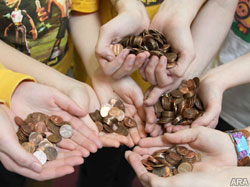
(ARA) – Making community service a required part of school curriculum is a growing trend sweeping through schools across North America, as is the teaching of core values, such as fairness, respect and collaboration.
Educators agree that embracing service learning and character education, in addition to bringing benefits to the community, is also improving academic outcomes and student behavior.
“We wanted to get to a place where all of our young people understand their place in the world and how they can make an impact,” says Guilford County, N.C., Schools Superintendent Maurice Green, in a recent interview in The Generator, a publication of the National Youth Leadership Council. As teachers work to incorporate these elements into the classroom they are welcoming innovative ideas from diverse sources.
Recognizing the need, The Leukemia & Lymphoma Society, the world’s largest voluntary health agency dedicated to blood cancer research and patient services, has designed 14 lesson plans for teachers to use in the classroom. The lesson plans integrate the themes of LLS’s Pennies for Patients and Olive Garden’s Pasta for Pennies programs into all academic areas.
Both programs encourage students to collect spare change to help fund lifesaving cancer research and patient services. Nearly 90 percent of children diagnosed with leukemia now survive thanks to remarkable research advances, but many are still dying. The programs hit home with the students because they are a way to directly benefit children who are diagnosed with cancer.
School teachers and staff across North America, such as Kim Stetzel, a fourth grade teacher in St. Louis, have long recognized the value of LLS’s School & Youth programs, which operate in more than 25,000 schools.
Stetzel says a lesson plan she will teach this year fits perfectly with her history class. “Marching Through Time” has students creating a series of timelines – one of significant events in their own lives, one of noteworthy events in Missouri and one on the progress in research, discoveries, treatment options and cure rates of childhood leukemia.
“This lesson plan personalizes the concept of timelines for the children and teaches them about important events in history and in the advancement of treatments for a disease that impacts their peers,” says Stetzel.
While Stetzel’s students are participating in the lessons in class, they are also engaging in real life lessons as they raise funds to help support the research that has given so many of their peers the hope of living longer, better lives. Stetzel’s students participate in Pennies for Patients to honor a schoolmate, fifth-grader Adam Bristoe, who is a leukemia survivor.
Stetzel has used other lessons as well. A few months ago, as part of her math lessons, she used the “Lucky Penny” lesson plan and last year her students wrote and performed a play on leukemia awareness and friendship.
“These lesson plans to help to enrich the learning experience of my students,” says Stetzel. “They are learning important concepts in a variety of subjects while doing a service that improves the community.”





